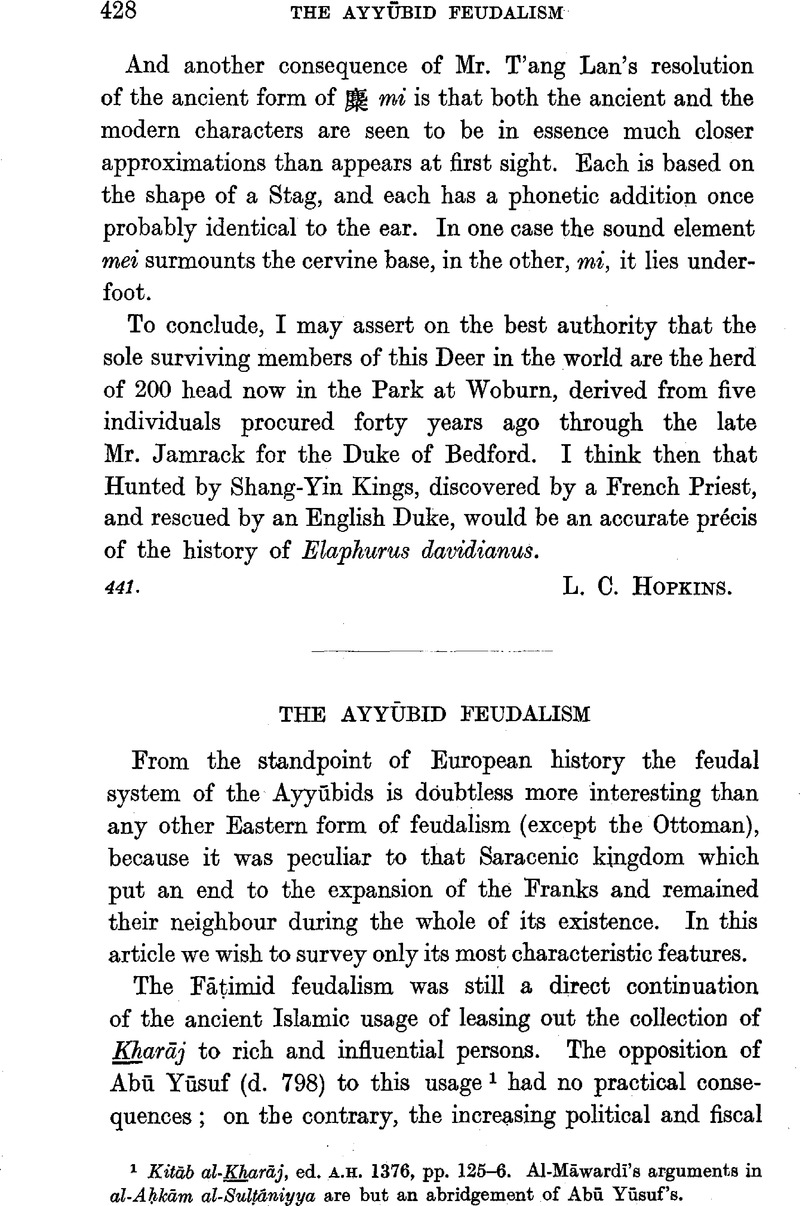
page 428 note 1 Kitāb al-Kharāj, ed. a.h. 1376, pp. 125–6. Al-Māwardī's arguments in al-Aḥkām al-Sulṭāniyya are but an abridgement of Abū Yūsuf's.
page 429 note 1 Al-Qalqashandī, Ṣubḥ, xiii, pp. 123–131, 139–143, copies two charters conferring the hereditary right of farming upon Iraqian families. The former was issued by Caliph al-Muti', the latter by Caliph al-Ta'i' and the Buwayhid Sultan, Samsam al-Dawla.
page 429 note 2 Cf. Khiṭaṭ, i, p. 82, 1. 5; p. 83, 1. 13; and Ṣuḥl, xiii, p. 133,11. 15–19; p. 135, 1. 20.
page 429 note 3 In the fourteenth century there were still in the town of Uṣfūn in Egypt Ismā'īlī, Shī'ite, and Druse communities: al-Dimashqī, Nukhbat al-Dahr, ed. Mehren, , p. 233, 1. 12Google Scholar.
page 429 note 4 Khtat, i, pp. 85–6; Ṣubḥ, iii, p. 524.
page 429 note 5 Sulūk of al-Maqrīzī, Quatremère, i, p. 40 ff. (still in 1253 !).
page 430 note 1 Al-'Umarī, al-Ta'rīf, p. 15, 1. 18; Subb, xiii, pp. 247–8; 'Imād al-Dīn al-Iṣfahānī, al-Fatḥ al-Qussī, p. 38, 1. 5; Abū Shāma, Kitāb al-Rawḍatayn, ii, p. 90,1. 6, etc. It appears from Ṣubḥ, xiii, p. 245,11. 8–21, that the Mamlūk Sultans were chiefs of the Syrian Ismā'īlīs not as apostles of the Nizari branch but as lieutenants of the Musta'lī, which seems to mean that the Light of Imamat was supposed to pass from one ruler of Egypt to another (it may be mentioned that during the reign of Shajar al-Durr her son, Khalīl, was denoted as amīr al-mu'minīn: Sulūk, ed. Ziyāda, , i, ii, p. 362, 1. 6)Google Scholar, but possibly also that the Mamluk Sultans were considered as representatives of those Fatimid Imams who were believed by al-Qalqashandi and al-Zahiri to survive somewhere in the Maghrib (cf. Abu Shama. ii, p. 178).
page 430 note 2 Cf. our notes in Revue, des Ètudes Islamiques, 1936, p. 261.
page 430 note 3 Abū Shāma, ii, p. 200, 1. 1. Anyway, the Ayyūbids did not resort to such inflation of paper currency (qarāṭīs) as the Zangid State.
page 430 note 4 Cf. Ṣubḥ, xiii, p. 138, 1. 2 ('idda= the contingent of horsemen maintained by a military fief-holder: cf. vi, p. 202, 1. 4).
page 431 note 1 Ṣubḥ, xiii, p. 128,1. 1; p. 132, 1. 4; p. 133, 1. 15; p. 142, 1. 18; p. 143, 1. 5.
page 431 note 2 Abū Shāma, ii, p. 197, 11. 22–23, 35.
page 431 note 3 Ṣubḥ, xiii, p. 150, 11. 1–7; p. 152,11. 5–15.
page 431 note 4 Abū Shāma, ii, p. 179,1. 18. This usage disappeared when the Sultanian Mamlūk corps was created.
page 431 note 5 Abū Shāma's notes on the heredity of fiefs are copied in Khiṭaṭ, ii, p. 216, 11. 24–26, where the source is not indicated.
page 432 note 1 Abū Shāma, ii, pp. 202, 208.
page 432 note 2 The question how long the northern Nubian kingdom existed and why the riverain strip from Aswān to Dongola has retained its Nubian speech, posed by S. Hillelson in this Journal, 1937, p. 659, is largely solved by the information contained in Ṣubḥ, viii, pp. 5–8. We learn from there that in the fifteenth century (and probably up till the Funj invasion) this strip remained independent, though already thoroughly Muslim, whilst Bedouin tribes settled to the south of it.